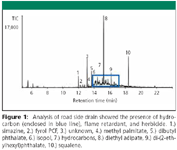On-Site Sample Preparation Using MEPS for Waste Water Analysis
The Application Notebook
MEPS uses a barrel insert and needle (BIN) device to reduce Solid-Phase Extraction (SPE) to a micro-scale suitable for small volume samples and for the online adaptation of conventional SPE techniques. Because the SPE cartridge (BIN) is incorporated into the needle assembly of a gas-tight syringe, MEPS is also a simple field-portable SPE device that may be operated manually without need for sampling pumps or, alternatively, may be incorporated into robotic samplers. MEPS devices are of glass and stainless steel construction allowing them to be fully immersed for sampling at depth or, alternatively, used at needle depth to avoid perturbing the stream from which the sample was drawn. An extension pole allowed MEPS to be used to sample back along pipes or down inspection vents. When sampling from drainage pits and open sumps, there was minimal requirement to remove grates to gain access. An extension pole also allowed sampling from outflows that were offensive and could be readily adapted for safe sampling of..
Paul Wynne, Yi Huang, Roy Hibbert, Dan DiFeo, and Peter Dawes, SGE Analytical Science
MEPS uses a barrel insert and needle (BIN) device to reduce Solid-Phase Extraction (SPE) to a micro-scale suitable for small volume samples and for the online adaptation of conventional SPE techniques. Because the SPE cartridge (BIN) is incorporated into the needle assembly of a gas-tight syringe, MEPS is also a simple field-portable SPE device that may be operated manually without need for sampling pumps or, alternatively, may be incorporated into robotic samplers. MEPS devices are of glass and stainless steel construction allowing them to be fully immersed for sampling at depth or, alternatively, used at needle depth to avoid perturbing the stream from which the sample was drawn. An extension pole allowed MEPS to be used to sample back along pipes or down inspection vents. When sampling from drainage pits and open sumps, there was minimal requirement to remove grates to gain access. An extension pole also allowed sampling from outflows that were offensive and could be readily adapted for safe sampling of toxic materials or where the sample was hot or otherwise dangerous.
To demonstrate the application of MEPS we report the qualitative field use of C18-MEPS for the sampling of water bodies in both industrial and urban environments. Water samples were extracted on-site and then the MEPS syringes were transported back to the laboratory overnight for elution and analysis of the retained components. C18-MEPS was used to extract samples of water from industrial drains and stormwater pipes to recover semi-volatile residues for GC–MS analysis (Figure 1).

Figure 1
Analysis of the unknown samples was qualitative but sufficiently sensitive to detect industrial discharge residues associated with packaging materials and other contaminants. Naturally occurring leachates from vegetation were also detectable.
Method
Storm water was sampled (1 mL total volume, 10 × 100 μL at 10 μL/sec) on a methanol conditioned C18-BIN MEPS device. The sorbent was dried with air (3 × 100 μL at 100 μL/s) and returned to the laboratory. Immediately prior to analysis, the MEPS BIN was eluted with methanol (20 μL) and 2 μL of sample analyzed by GC–MS.
GC–MS method: Analysis used an Agilent 6890 GC-5973N MSD and a BPX5 column (30 m × 0.25 mm ID with a 0.25 μm film thickness). Injector temperature was 270°C and injection was splitless. The oven temperature was 40°C (4 min) the 20°C/min to 250°C (10 min). Transfer line was 280°C, source 230°C and quadrapole 180°C. Scan range was 40–500 Da at 2 scan/s.
By using only a portion of the MEPS eluate, the amount analyzed was the equivalent of 100 μL of stormwater. The water sample showed the presence of the herbicide simazine as well as hydrocarbons typical of mineral diesel fuel (road surface and air), plastics residues (plastic waste and packaging), and flame retardant used in polystyrene and other applications (packaging and other refuse). Simazine is likely to have been applied to weeds in nearby industrial land or roadside areas. No weed growth was evident within five meters of the sample collection area nor was the water flow from a weed affected area.
Conclusion
MEPS was found to be suitable for the in-field extraction of water samples with the stages of sample loading (field based) and clean-up and elution (laboratory based) separated. Manual operation of the syringe pump allowed sampling without the need for portable power supplies or other sampling paraphernalia. MEPS was found to be suitable for detecting residues from land management and commercial activities in storm water. Enhanced concentration of analyte can be achieved using MEPS in combination with a larger volume syringe and/or more sampling cycles and by analyzing a greater proportion of the MEPS eluate.
Where testing protocols allow, the field portability of MEPS can eliminate the need to recover and stabilize samples for transport to the laboratory. Specifically, we have made use of the small size, ease of use, and mechanical stability of the MEPS syringe to allow us to demonstrate the provision of a sampling service to a remote site without the need for transporting hazardous materials or unstable samples.

SGE Analytical Science
2007 Kramer Lane
Austin, Texas 78758
Tel 11 (800) 945-6154; Fax 11 (512) 836 9159
Email: usa@sge.com

Separation of Ultra-Short and Long Chain PFAS Compounds Using a Positive Charge Surface Column
December 11th 2024A separation of ultra-short and long chain PFAS (C1-C18) is performed on a HALO®PCS Phenyl-Hexyl column along with a HALO®PFAS Delay column which demonstrates excellent retention for both hydrophilic and hydrophobic analytes.















